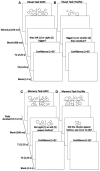Cross-Domain Association in Metacognitive Efficiency Depends on First-Order Task Types
- PMID: 30564183
- PMCID: PMC6288301
- DOI: 10.3389/fpsyg.2018.02464
Cross-Domain Association in Metacognitive Efficiency Depends on First-Order Task Types
Abstract
An important yet unresolved question is whether or not metacognition consists of domain-general or domain-specific mechanisms. While most studies on this topic suggest a dissociation between metacognitive abilities at the neural level, there are inconsistent reports at the behavioral level. Specifically, while McCurdy et al. (2013) found a positive correlation between metacognitive efficiency for visual perception and memory, such correlation was not observed in Baird et al. (2013). One possible explanation for this discrepancy is that the former included two-alternative-forced choice (2AFC) judgments in both their visual and memory tasks, whereas the latter used 2AFC for one task and yes/no (YN) judgments for the other. To test the effect of task on cross-domain association in metacognitive efficiency, we conducted two online experiments to mirror McCurdy et al. (2013) and Baird et al. (2013) with considerable statistical power (n = 100), and replicated the main findings of both studies. The results suggest that the use of task could affect cross-domain association in metacognitive efficiency. In the third experiment with the same sample size, we used YN judgments for both tasks and did not find a significant cross-domain correlation in metacognitive efficiency. This suggests that the cross-domain correlation found in McCurdy et al. (2013) was not simply due to the same task being used for both domains, and the absence of cross-domain correlation in Baird et al. (2013) might be due to the use of YN judgments. Our results highlight the importance of avoiding confusion between 2AFC and YN judgments in behavioral tasks for metacognitive research, which is a common problem in many behavioral studies.
Keywords: 2AFC task; behavioral task; domain-general; domain-specific; metacognition.
Figures




References
-
- Berinsky A., Huber G., Lenz G. (2012). Evaluating online labor markets for experimental research: amazon.com's mechanical turk. Pol. Anal. 20, 351–368. 10.1093/pan/mpr057 - DOI
-
- Cohen J., Cohen P. (1983). Applied Multiple Regression/correlation Analysis for the Behavioral Sciences. Hillsdale, NJ: Erlbaum.
Associated data
Grants and funding
LinkOut - more resources
Full Text Sources

